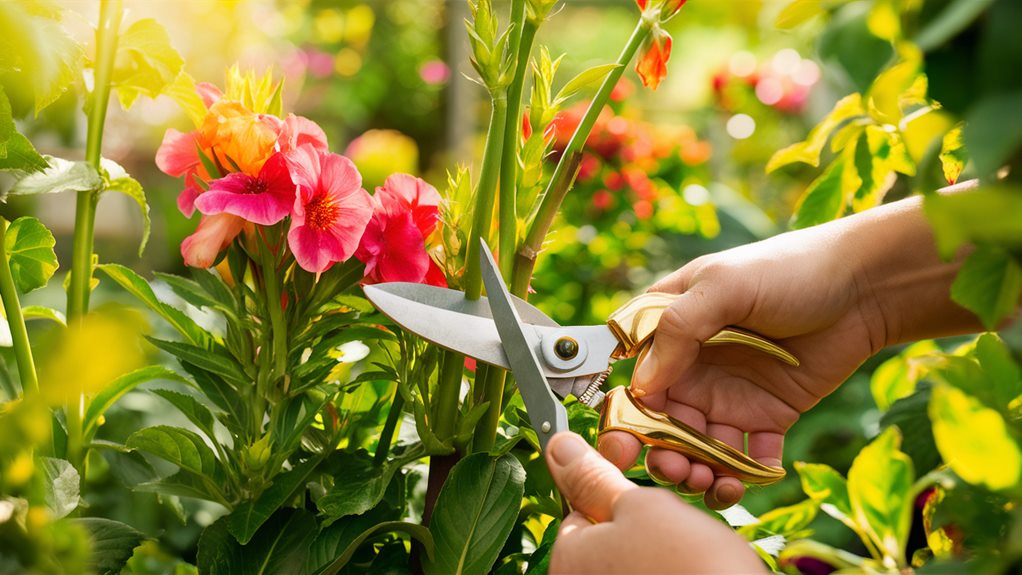To master effective pruning techniques, start with the basics: always use sharp, clean tools like bypass pruners for small branches and loppers for larger ones. Timing is essential—prune spring-flowering plants after blooming and summer varieties in late winter. Focus on removing dead or diseased wood, and limit cuts to no more than 25% of the plant at once to avoid stress. Make clean cuts at a 45-degree angle to promote healing. Regular maintenance guarantees vibrant growth. Stick with these principles, and you'll find your plants thriving. For additional insights into specific techniques and tools, keep exploring the topic.
Key Takeaways
- Use sharp, clean tools to ensure precise cuts and promote faster healing for your plants.
- Prune at the right time based on plant type, such as post-bloom for spring flowers.
- Apply various techniques tailored to plant needs, including thinning, heading, and rejuvenation pruning.
- Avoid common mistakes like over-pruning and cutting too close to the trunk to reduce stress on plants.
- Regularly maintain and sanitize your tools for optimal performance and to prevent disease spread.
Understanding Pruning Basics
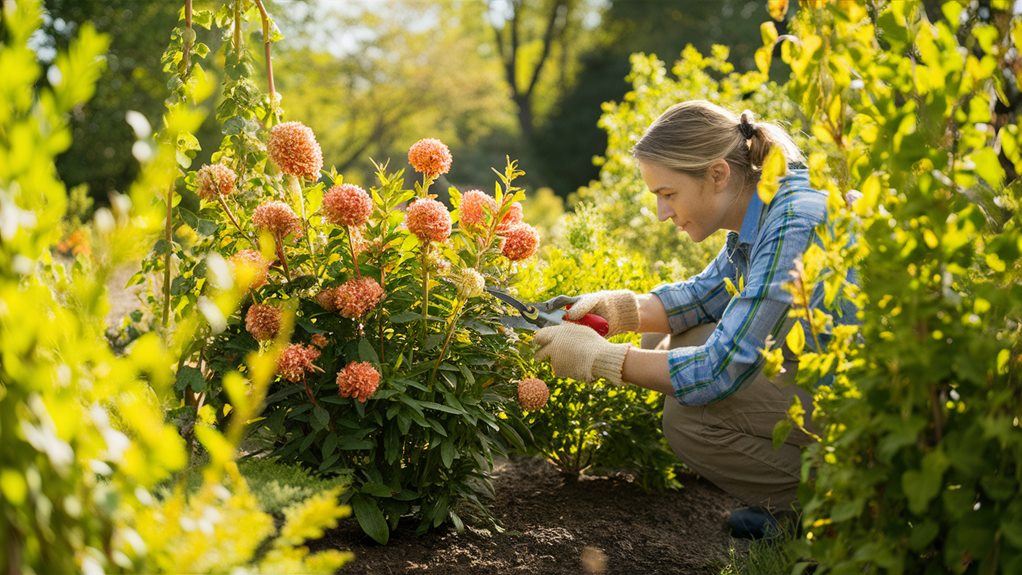
Understanding pruning basics is crucial for maintaining healthy garden plants. By mastering these fundamentals, you'll engage in practices that not only enhance your garden's vitality but also foster a sense of belonging within your gardening community. The benefits of pruning extend beyond aesthetics; it promotes air circulation, encourages new growth, and helps prevent disease. Additionally, using the right tools, such as high-quality pruning shears, can greatly improve your pruning efficiency and effectiveness.
To get started, familiarize yourself with various pruning techniques. The most common methods include thinning, heading, and rejuvenation. Thinning involves selectively removing branches to improve light penetration and airflow, while heading entails cutting back the tips of branches to encourage bushier growth. Rejuvenation, on the other hand, is a more radical approach, where you cut older plants back to ground level to stimulate fresh growth.
When you apply these techniques effectively, you'll notice healthier, more productive plants. Always remember to use sharp, clean tools to make precise cuts, as this minimizes damage and promotes healing.
Timing Your Pruning
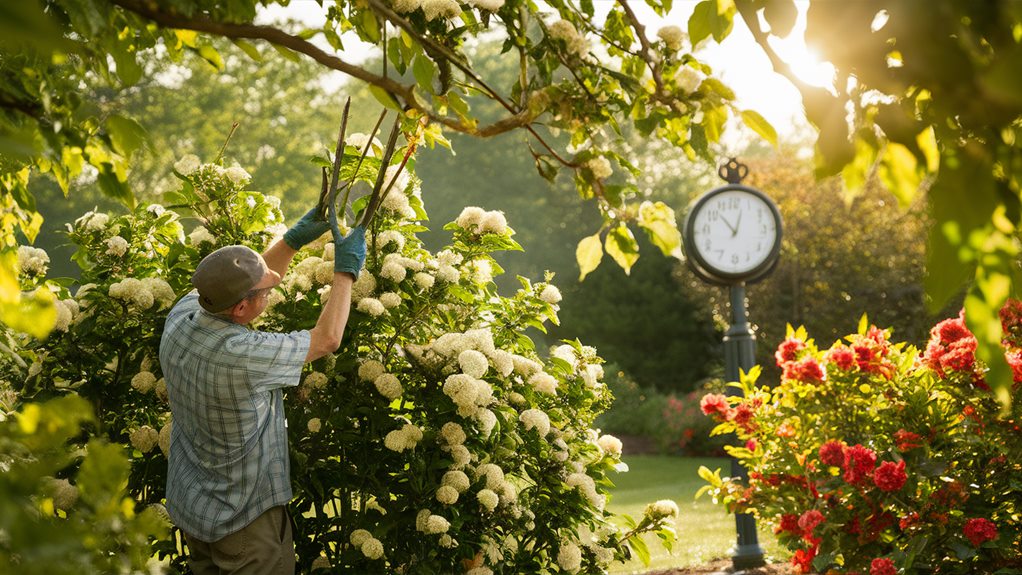
Timing your pruning is just as crucial as the techniques you choose. To maximize the pruning benefits, you need to follow specific pruning schedules tailored to each plant type.
For example, spring-flowering shrubs should be pruned right after they bloom, while summer-blooming varieties are best pruned in late winter or early spring before new growth begins. Moreover, using high-quality tools can make a significant difference in the effectiveness of your pruning efforts, as they provide cleaner cuts that promote faster healing.
Selecting tools made from long-lasting materials ensures longevity and reliability during your gardening tasks.
Knowing when to prune can help promote healthy growth and vibrant blooms. If you prune too late in the season, you risk cutting off buds that would've developed into flowers. Conversely, pruning too early can weaken a plant, making it susceptible to disease.
You should also consider your local climate. In warmer regions, the growing season might start earlier, impacting your pruning schedule. Regularly evaluating your plants and adjusting your timing accordingly can yield significant results.
Essential Pruning Tools

When it comes to effective pruning, having the right tools at your disposal is essential for achieving clean cuts and promoting plant health. Start with bypass pruners, which are perfect for smaller branches and provide a clean slice, reducing the risk of disease.
For larger branches, consider loppers; their long handles give you the leverage needed for tougher jobs. A pruning saw is invaluable for thick branches, ensuring you can tackle even the most robust plants. Additionally, using a comfortable gardening experience can markedly enhance your pruning efforts, as it allows you to focus on the task without discomfort.
Choosing the right tools means understanding your specific pruning needs and the types of plants you work with. Each tool serves a unique purpose, so invest wisely. Don't forget about pruning tool maintenance—cleaning and sharpening your tools regularly will enhance performance and longevity.
A simple wipe with disinfectant prevents the spread of diseases between plants, while sharp blades make the task easier and more efficient.
Incorporating these tools into your gardening routine won't only improve your pruning skills but also foster a sense of community among fellow gardeners. By sharing experiences and tips, you can enhance your gardening journey together while ensuring your plants thrive.
Techniques for Different Plants
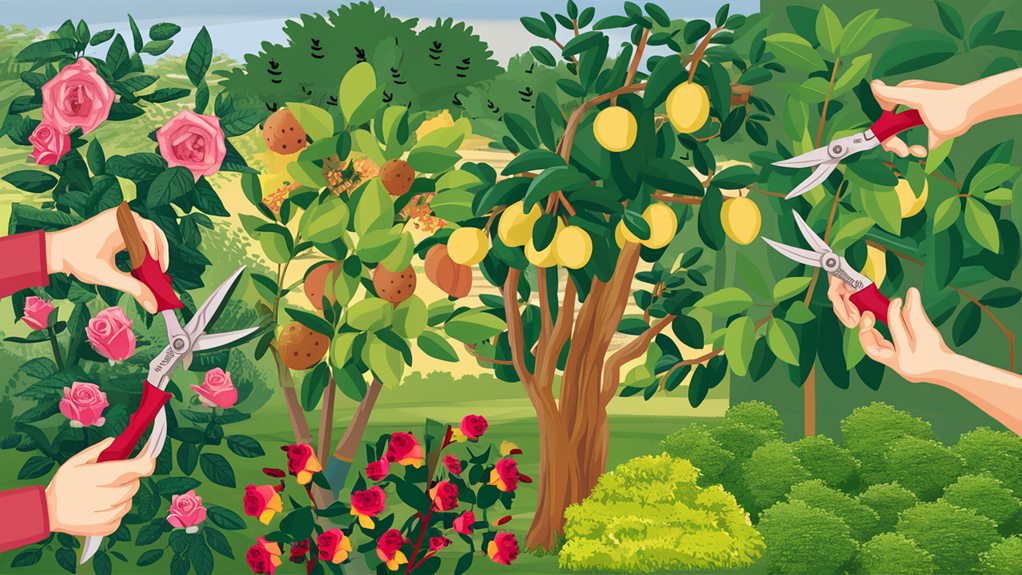
Although each plant species has its own unique needs, mastering specific pruning techniques can enhance their growth and health. When it comes to fruit trees, focus on shaping during the dormant season. Remove any dead or crossing branches to improve airflow and light penetration. Aim for an open center structure, which allows sunlight to reach all parts of the tree, promoting even fruit production. Always cut back to a healthy bud or branch to guarantee proper healing.
For flowering shrubs, timing is key. Prune spring-blooming varieties right after they flower to avoid cutting off next year's blooms. For summer-blooming shrubs, you can prune them in late winter or early spring. Remove older stems close to the base to encourage new growth, as this rejuvenates the plant and enhances blooming.
Both fruit trees and flowering shrubs benefit from regular maintenance. By understanding their specific needs and applying tailored techniques, you're securing a vibrant and productive garden.
Don't be afraid to experiment, as each cut can lead to healthier plants and a more beautiful landscape, fostering your connection to nature and your gardening community.
Common Pruning Mistakes
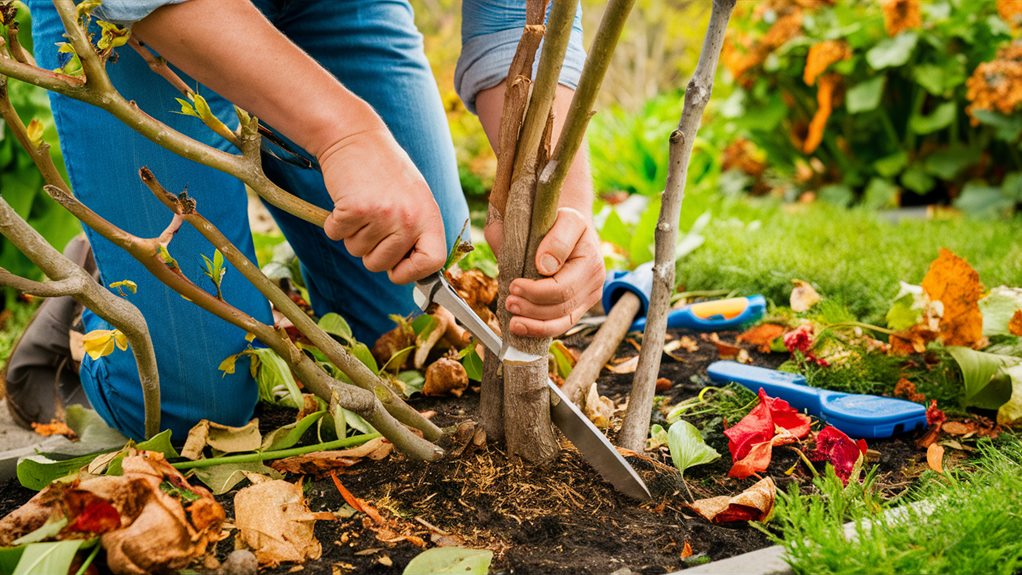
Understanding specific pruning techniques can help you avoid common mistakes that might obstruct your plants' growth. One significant error is overpruning. When you remove too much foliage, you risk stressing your plants, which can lead to poor health and reduced blooms. Aim to prune selectively, ensuring you're not cutting more than 25% of the plant at once.
Proper branch selection is pivotal. Focus on cutting branches that are crossing or growing inward, as these can create clutter and block sunlight.
Always prune for shape, maintaining a balanced appearance that encourages healthy growth.
Another mistake to watch out for is stub cuts. These leave behind jagged edges that can become entry points for pests and diseases. Instead, make clean cuts just above a healthy bud or branch to promote healing and growth.
Seasonal Pruning Guide
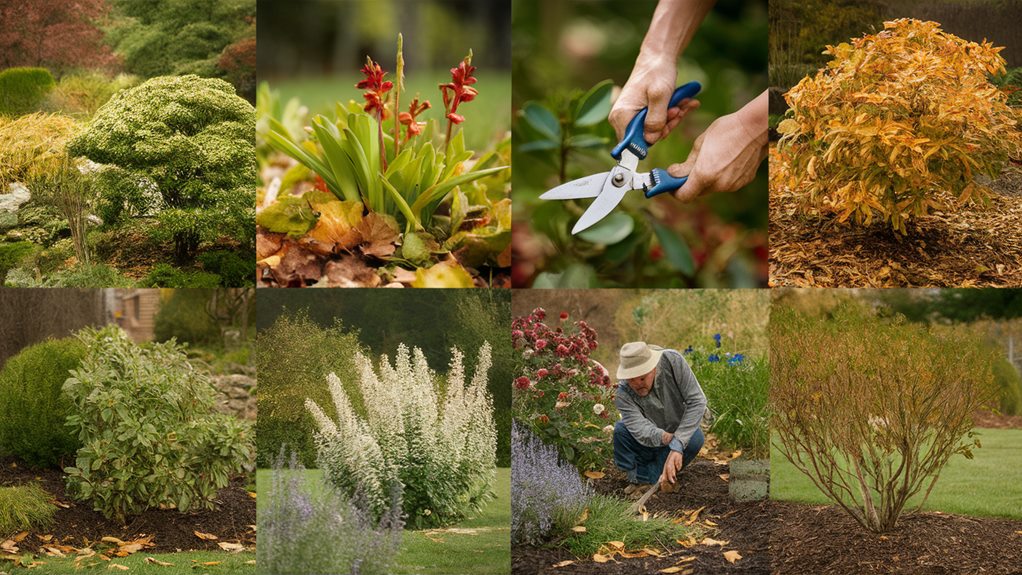
A seasonal pruning guide is crucial for maintaining the health and aesthetics of your garden plants. To [GUARANTEE] you're following a proper pruning schedule, consider the seasonal needs of each type of plant in your garden.
For spring-flowering shrubs, prune just after they bloom to encourage new growth. In summer, focus on trimming back perennials and deadheading flowers to promote more blooms.
Fall is the perfect time for shaping evergreen shrubs and removing any dead or diseased branches. This prepares them for winter while encouraging robust growth come spring.
Winter pruning, though counterintuitive, can be beneficial for many deciduous trees and shrubs. This is when you should address any structural issues and thin out crowded branches, as they're easier to see without foliage.
Benefits of Pruning

Regularly trimming your garden plants offers numerous benefits that enhance their health and appearance. One key benefit is pruning for growth. By removing dead or overcrowded branches, you allow more sunlight and air to penetrate the plant's interior, promoting better circulation and encouraging vigorous growth. This practice also helps redirect the plant's energy towards healthier branches, resulting in stronger and more resilient specimens.
Additionally, pruning for aesthetics markedly improves your garden's visual appeal. By shaping your plants and maintaining their size, you create a well-balanced landscape that's pleasing to the eye.
Thoughtful pruning can also encourage blooming, as many flowering plants benefit from being cut back, producing more vibrant and abundant flowers.
Moreover, regular pruning helps prevent pests and diseases by removing affected parts before issues spread. This proactive approach ensures your plants stay healthy and thriving.
Frequently Asked Questions
Can I Prune During Heavy Rain or Storms?
You shouldn't prune during heavy rain or storms due to pruning safety issues. Wet conditions can make tools slippery, increasing the risk of accidents. Additionally, pruning timing is essential; wet foliage can promote disease.
Wait for dry weather to make sure you have a secure grip and a clear view of what you're doing. By selecting the right time, you'll protect both yourself and your plants, promoting ideal health and growth.
How Do I Know if My Plant Needs Pruning?
To know if your plant needs pruning, look for signs of overgrown plants, like dense foliage or branches crossing each other. If it seems leggy or has dead or diseased parts, it's time to act. Timing matters, so choose suitable conditions—preferably dry weather—to minimize stress on the plant.
Regularly evaluating your plants helps maintain their health and encourages vibrant growth, ensuring they thrive in your garden space.
What Should I Do With Pruned Plant Material?
You might think pruned plant material's just waste, but it can be quite valuable. Consider composting it; the benefits include enriching your soil and reducing waste.
If you prefer recycling options, you can create mulch or wood chips for your garden.
Alternatively, get creative with DIY projects—use branches for rustic home decor or leaves for crafting. Each option helps you connect with nature while making the most of your garden's resources.
Is There a Specific Pruning Technique for Fruit Trees?
When it comes to pruning fruit trees, you'll want to focus on proper timing and the correct tools.
Prune during late winter or early spring before new growth starts. Use sharp, clean pruning shears or saws to make precise cuts and reduce stress on the tree.
Aim for an open center to promote airflow and sunlight penetration. This technique encourages healthy growth and better fruit production, ensuring your trees thrive in your garden.
How Can I Encourage Faster Regrowth After Pruning?
To encourage faster regrowth after pruning, focus on regrowth stimulation by promoting plant health. Regularly assess your plants' growth patterns and adjust your pruning frequency accordingly. Remove dead or damaged branches to redirect energy towards new growth.
Fertilize with a balanced nutrient mix post-pruning, and maintain proper watering. These practices create a favorable environment for your plants, fostering quicker recovery and stronger growth, helping you nurture a thriving garden community.
Conclusion
To sum up, mastering pruning techniques not only enhances the beauty of your garden but also cultivates the health of your plants, much like a sculptor revealing a masterpiece from a block of stone. By understanding the basics, timing your cuts, and using the right tools, you'll avoid common pitfalls and reap the rewards. Remember, each snip is a step toward essentiality and growth, ensuring your garden flourishes season after season. Embrace the art of pruning and watch your landscape transform.

